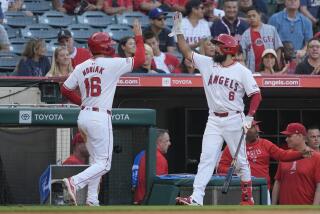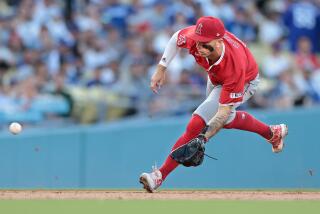POSITION OF INFLUENCE
- Share via
TEMPE, Ariz. — Way down the list of vote-getters for the 2004 American League most-valuable-player award, far behind superstars Vladimir Guerrero, Gary Sheffield, Manny Ramirez, Miguel Tejada and Alex Rodriguez, in 29th place to be exact, was Chone Figgins.
The Angel utility player’s total of two points, for the two 10th-place votes he received, seemed minuscule compared to the triple-digit figures at the top of the charts. But to Figgins, those votes represent “one of the greatest accomplishments I’ve ever had,” he said. “To even be mentioned as an MVP candidate was a great honor.”
Figgins wouldn’t have been any more thrilled if the list had been turned upside down because his receiving votes showed how far he’d come in three years, from a pinch-runner as a September call-up in 2002, to a part-time player in 2003, to an impact everyday big leaguer in 2004.
Guerrero and Jose Guillen provided most of the power to a lineup that missed Garret Anderson and Troy Glaus for months at a time in 2004, but it was Figgins whom Angel Manager Mike Scioscia constantly touted as the team’s MVP.
The versatile, speedy Figgins started at five positions -- shortstop, center field, third base, second base and right field -- fielding each proficiently, and hit in six lineup spots, first, second, third, seventh, eighth and ninth.
He batted .296 with five home runs, 17 triples, 22 doubles, 60 runs batted in, 83 runs and a team-high 34 stolen bases, and with the exception of August, when his average dipped to .269, he hit .283 or better in each month.
When Anderson went down with a back injury in early April, Figgins took over in center field, with an occasional start at third and shortstop. When Glaus was sidelined by a shoulder injury in mid-May, Figgins moved to third, with an occasional start in center and a short stint filling in for injured shortstop David Eckstein in June.
When Robb Quinlan’s bat caught fire in mid-July, Figgins moved back to center to make room for Quinlan at third. But when Quinlan tore a chest muscle in mid-August, it was back to third for Figgins.
Then Adam Kennedy suffered a season-ending knee injury Sept. 20, and Figgins took over at second, but only after having played second, center field and third that same night. “I can say with some certainty that we probably wouldn’t have played three [playoff] games in October without him,” first baseman Darin Erstad said of Figgins. “He was pretty valuable, and he was so versatile. It’s rare to find guys who keep their mouths shut and keep doing the job.”
No matter where that job took him.
“You never knew where I was going to end up,” he said. “That was always the mystery of it.”
Figgins didn’t mind being the Swiss Army knife in Scioscia’s pocket, the utility player with the tools -- he carries four gloves, one for each infield position and one for the outfield -- for every occasion.
“As long as I was getting at-bats, who’s to complain?” Figgins said.
But he will settle into one spot for at least the first month of 2005, filling in for the injured Kennedy at second.
He has quickly gained an on-field rapport with new shortstop Orlando Cabrera this spring, turning a number of flashy double plays, and Figgins made a superb play in Friday’s exhibition game against the Chicago Cubs, ranging behind second base to backhand Nomar Garciaparra’s grounder, leaping and throwing to first in time for the out.
When Kennedy returns, Figgins, who is batting .273 this spring, will probably return to his super utility role, spelling starters and getting time at designated hitter.
“I would love to play second base at one time, shortstop at one time, but if this is what’s going to keep me up here playing, I’m all for it,” Figgins said. “I’ve gotten used to bouncing around, and it’s neat being able to see the game from different positions.... Starting in one spot doesn’t matter. Being on the field is the most important thing.”
Especially on the basepaths. Figgins showed excellent range in center and strong defensive skills in the middle-infield spots, but his biggest impact was on offense, whether it was legging out a triple on a ball that didn’t reach the wall, stealing second or going from first to third on a single.
He should be more powerful this season after adding 10 pounds of muscle to his upper body -- the 5-foot-7 Figgins, 27, now weighs 185 pounds -- and he hopes to be more explosive on the basepaths after working out this winter in Florida with Juan Pierre, who stole 45 bases for the Florida Marlins last season.
“I get good leads, and he gets better jumps, so we were trying to put it all together,” said Figgins, who roomed with Pierre when they were minor leaguers in Colorado’s organization. “We watched tapes of Rickey Henderson and Vince Coleman and worked on things like how you set up and footwork. I’m always open to learning.”
Figgins learned his biggest lesson last October, when playoff jitters led to some shaky play in the AL division series against Boston. Starting at third base in Game 1, he misplayed a grounder in the first inning and threw wildly past home with the bases loaded in the fourth, costly mistakes in a 9-3 loss.
Playing second base in Game 3, Figgins’ fielding error with one out in the fourth paved the way to a three-run Red Sox inning, and his ninth-inning base-running gaffe, when he misread Erstad’s double off Fenway Park’s Green Monster and failed to score from first, cost the Angels a chance to score the winning run. He went two for 14 with five strikeouts in the series.
“I didn’t play like myself,” Figgins said. “I got caught up in the ‘Wow, we’re in the playoffs!’ thing. If we get there this season, it won’t be the same story. I talked to Garret and Juan about it -- they both have World Series rings. I didn’t calm myself down, and that didn’t help me play my game.”
Scioscia says Figgins came away from the playoffs “with an understanding that even though more is riding on the playoffs, you still need to play your game.”
“It makes you a better player when you’re put in that situation,” Scioscia said. “It gives you a perspective of what playoff baseball is like.”
*
*
(BEGIN TEXT OF INFOBOX)
Figgins Factor
Chone Figgins’ major league statistics, all with the Angels. The switch-hitter is 5 feet 7, 185 pounds and 27 years old:
*--* Year G AB R H 2B 3B HR RBI BB SO SB CS Avg 2002 15 12 6 2 1 0 0 1 0 5 2 1 167 2003 71 240 34 71 9 4 0 27 20 38 13 7 296 2004 148 577 83 171 22 17 5 60 49 94 34 13 296 TOTAL 234 829 123 244 32 21 5 88 69 137 49 21 294
*--*
More to Read
Go beyond the scoreboard
Get the latest on L.A.'s teams in the daily Sports Report newsletter.
You may occasionally receive promotional content from the Los Angeles Times.








